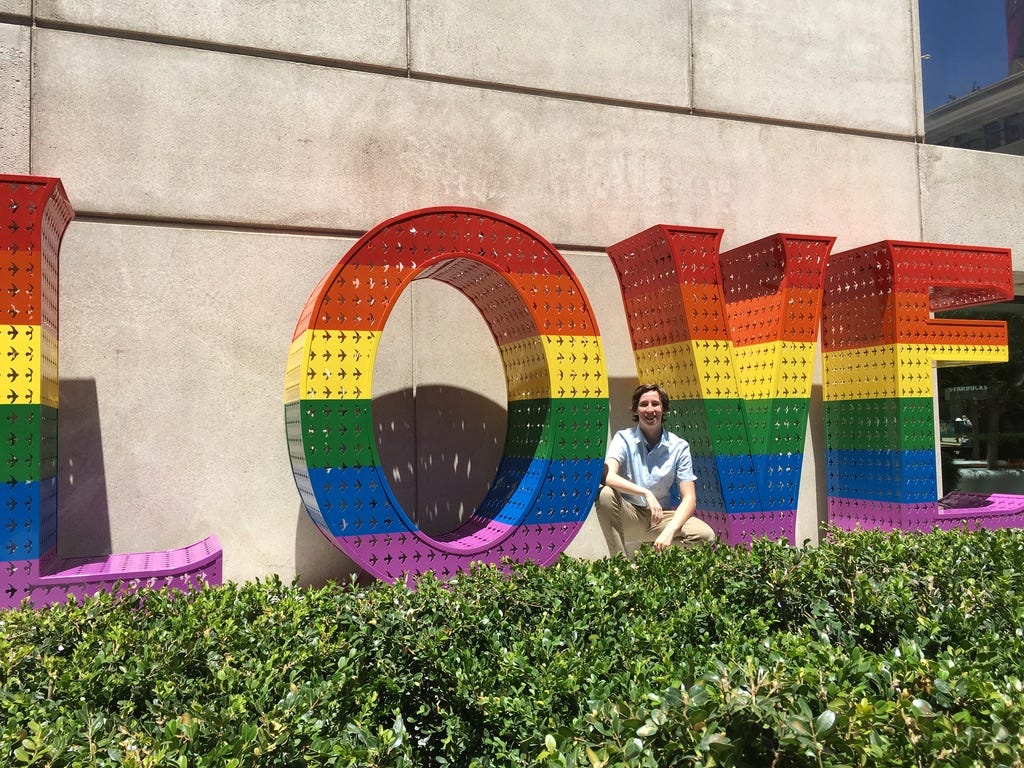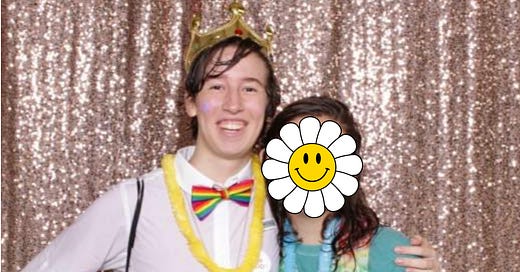Happy last day of Pride Month, everyone! Today in Gay is currently wrapping things up before we head into a July hiatus. To send us all off into the rest of the year post-Pride, we have a guest post from our friend Ben Greene, creator of Good Queer News and the best trans brother we can ask for!
♥︎ TiG Team
“Resist the urge to glue your eyes to the horizon and say that nothing counts yet because there is more fight to be had. Look down at your feet, look to your sides at where we are right now and what we've fought for. Look at the incredible, brilliant, powerful resilience and resistance of the advocates standing next to you.”
What Does Pride Mean? What Could it Mean?
This pride month has felt different. For some, it feels much closer to Stonewall‘s riotous roots. For others, it feels like a unique moment of fear and erasure. Others still might’ve been feeling too burned out to even think about pride. Some of us took a lasered-in focus on joy and found opportunities to celebrate wherever we could.
For most of us, I’m betting it was a messy combination of all of these and more. We’re reaching a critical moment in our movement of trying to figure out what pride means, what the role of pride is.
Zooming In
My first thought when I’m asked what pride means to me is to zoom in on how it might feel for someone attending their first pride. For a trans kid draped in their trans pride cape, high-fiving a cool looking older dude with his own trans pride cape. I’ve been that kid. I’ve been and I’m becoming that older dude. I’m still both, wide-eyed with excitement and possibility for my future, and so honored that I get to look back to where I came from and be that for somebody else. Each time I’m on either side of that high five, I think: this is what pride is for.
It can be tempting to pull into despair at this notion; to say, "Ben! There are so many challenges for the kids. The bans, the laws, the politics, we don't have time to talk about a party right now." But I wholeheartedly disagree. That high-five is the point. The visibility is the point. The possibility is the point.

The first year of my transition I didn't come out to anyone because I had never in my life heard a positive coming out story. I stayed in the closet, miserable and alone, because I didn't know there was a possibility of support.
The first 3 years of my transition, I assumed that I wouldn't live past 21 because never in my life had I seen a trans adult—especially a trans man—surviving or thriving. I didn't bother dreaming about my future or hoping to grow up because I didn't know it was possible.
There were so many moments in those years that I seriously doubted whether I wanted to be alive. What did I have to look forward to?
But as I found community, as I found role models, as I found representation on TV and in books, and yes, as I found pride, I found hope. More specifically: I found hope for a future in which I was seen and loved exactly as I am by myself and others.

We have such hardcore mental-health messaging when it comes to legislation and healthcare access for trans youth, and I think sometimes it's very persuasive and impactful, but I also think it's flattened the purpose of gender affirming care. "Gender affirming care saves lives" is an awesome slogan for a poster, but only because "Gender affirming care provides one of many vital opportunities for trans folks to feel seen and loved as they are" doesn't usually fit on the cardboard.
The visibility and the hope we can provide at pride is, in many ways, too big to capture. It's not just, "I didn't realize I could grow a beard like that on T!" It's also seeing a trans man wearing a binder feeling handsome and free. It's about seeing a transfemme with a glitter beard being gendered correctly by the people around her. It's about checking out a free clothing swap that isn't sorted by gender where you can find clothes that feel like you, regardless of what label a store might have put on them, and still being complimented as you want to be. The possibility is the point. Showing young people that even if they aren't able to access care right away (though we're fighting fiercely to restore and defend their right to access that care), it is not the medicine that gives them access to validity, or visibility, or community. It is just their radical act of being.
Our fight for our rights, for our healthcare, for trans kids, isn't just a panicked review of suicide statistics. We are fighting and gathering and celebrating to show each other the world we're dreaming of, and of the future that's possible.
Zooming Out
That “Zooming In” moment is certainly part of why I love pride, but I also think if you zoom much further out and put this pride in a much larger context in terms of queer history and queer futures, we can apply much of the same thinking. If you'd like to do the same, I'm begging literally all queers and most allies too to pick up a copy of Marsha by Tourmaline.
"The first pride was a riot" is, once again, a really catchy slogan for a poster, but also ignores the rich legacy and power of joy and celebration at the core of the queer liberation movement at the time of Stonewall.
Yes, the Stonewall Inn uprising was a riot and is an incredibly important part of our history. Rioting, fighting back, and making good trouble, have and do and will have a critical role to play in changemaking. And in the same time period, queer activists were hosting "Gay Dances" at NYU for queer folks and allies to come together and celebrate. Gilbert Baker was hand sewing and dyeing a mile-long pride flag to be marched down the street in a joyful parade. Jeanne Manford was encouraging parents to publicly celebrate their love for their queer children while marching in the pride parade with her son and establishing the first PFLAG chapter. Marsha P. Johnson was throwing bake sales to cover rent for the STAR house and bail funds for fellow revolutionaries.
Activists were working hard, yes, and they were celebrating every second that they could. They were dressed to the nines, full drag, full makeup, full glam, in open defiance of "three items" laws. In an arguably far more hostile environment, where hope might have felt even further off than it does now, they partied, they danced, they laughed, they rested, and they lived to fight another day.
There are many reasonable criticisms to have of the over-corporatization of pride celebrations or the wasted energy of the "kink at pride" debates. I think our critiques of joy are not just misplaced but actively harmful.
To say in response to celebration and joy that the "first pride was a riot" is to strip those first protesters—who were literally protesting for their right to gather, dance, and party at the Stonewall Inn—of their joy. To say, "How dare you celebrate, there is so much further to go! There is work to be done!" is to paint joy as a luxury for the privileged few, as a dainty dalliance growing from ignorance.
True joy, revolutionary joy, the kind of joy I associate with pride, has dirty fingernails, bruised knuckles, and ripped stockings. Joy is hard fought and hard defended. Of course we have further to go, and we can use joy to dream of where that is and how we'll get there.
Resist the urge to glue your eyes to the horizon and say that nothing counts yet because there is more fight to be had. Look down at your feet, look to your sides at where we are right now and what we've fought for. Look at the incredible, brilliant, powerful resilience and resistance of the advocates standing next to you.
Look behind you! Look to the activists and revolutionaries who laid down their lives in the hope that one day you could walk down the street wearing more than 3 items of women's clothes. Marsha's dreams of robust mutual aid networks and increasing safety for trans women of color. Lou Sullivan's dreams for transmasculine community building and recognition of the existence of gay transmasculine people. Jeanne Manford's dream of parents feeling brave enough to celebrate their love for their LGBTQ+ children. ACT UP's dream for access to sex education, HIV testing, and an end to AIDS deaths.
We have so much further to go, but my god if it isn't incredible how far we've come since then. How far their dreams have taken us and how quickly we might take them for granted. We can and we must use pride as an opportunity to look around us, to look forward, to look backward, and to celebrate the beauty we find there.
Remember: We don't see the world as it is. We see the world as we are. If you decide to label this pride as one of erasure or abandonment, you'll certainly see the people who are missing. But you might spend so much time looking at the empty spaces in corporate floats or white house pride events that you miss what's come up in their place. Community-oriented and funded celebrations, city council resistance flags, and pride celebrations in big cities and tiny towns smashing their records for attendance. If you are someone who celebrates, someone who looks for joy, you will find it absolutely everywhere.






love love love Ben’s framing of pride and joy!! hope y’all’s July hiatus is full of life-giving rest and whimsical summer fun!